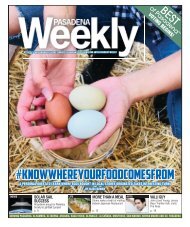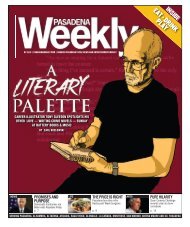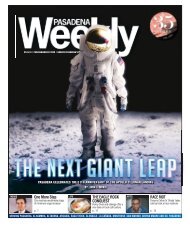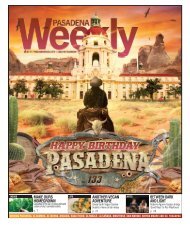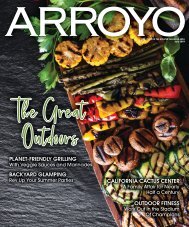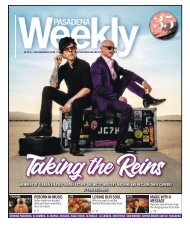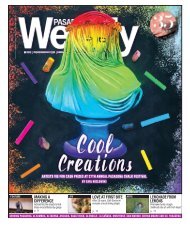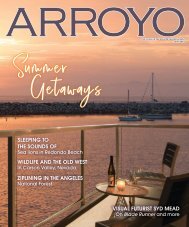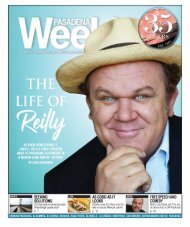October Arroyo 2018
You also want an ePaper? Increase the reach of your titles
YUMPU automatically turns print PDFs into web optimized ePapers that Google loves.
–continued from page 33<br />
with collectors. We’d asked them<br />
if they had A, B or C in their<br />
collection. They’d say, ‘But do<br />
you have E, F, and G in your<br />
book?’ We said, ‘Can we see images?’<br />
Then we’d fall in love, and<br />
we kept adding.” They tracked<br />
down names and backgrounds<br />
through newspaper clippings<br />
and files at libraries, historical<br />
societies and museums — and<br />
sometimes even found surviving<br />
family members. St. Gaudens’<br />
original list of 100 women artists<br />
eventually exploded to 320, and<br />
ended up filling four volumes.<br />
In collaboration with Morsman,<br />
St. Gaudens has curated<br />
an ambitious new exhibition<br />
Maurine St. Gaudens inspired by the books: Something<br />
Revealed; California Women<br />
Artists Emerge, 1860-1960 runs<br />
through March 31, 2019, at the Pasadena Museum of History. It will include some 300<br />
works, reflecting a wide variety of styles and subjects, by 160 artists; most are included<br />
in the books, but the show will also include a few artists they’ve discovered since publication.<br />
To present more works than the intimate museum can display at any one time,<br />
they will change out about 40 percent of the work midway through.<br />
A number of the artists, such as Ruth Asawa, Helen Lundeberg, Ynez Johnston,<br />
Agnes Pelton and June Wayne, will be familiar to art aficionados. Many others will be<br />
little known, if at all — even if some of their art may be familiar, as in the case of Ada<br />
May Sharpless. Sharpless was the sculptor who created the Art Deco–style Lady of the<br />
Lake (1934) statue at Echo Park Lake, as well as the statue of Juan Rodriguez Cabrillo<br />
(1933) at the Santa Ana Historical Museum (now the Bowers Museum).<br />
One of the pair’s proudest finds is Ruth Miller Kempster (1904–1978), whose<br />
painting Housewife (circa 1935) graces the cover of Volume 2 and will be a centerpiece<br />
in the exhibition. “It’s one of the greatest discoveries of the book,” says Morsman.<br />
Housewife is a sublimely painted<br />
oil on canvas of a woman in a red<br />
dress under a white apron, standing<br />
at the sink washing dishes and<br />
looking out with tired eyes at the<br />
viewer. Already the gaze of the<br />
female subject makes it unusual;<br />
for centuries women were looked<br />
upon, the passive subject of the<br />
male gaze, while in this painting<br />
the woman looks out actively.<br />
In the background is a young<br />
daughter returning a cup to the<br />
cupboard, and further back, in the<br />
dining room, is the husband reading<br />
the newspaper after dinner.<br />
It is a snapshot of 1930s Middle<br />
America after dinner — after the<br />
woman has cooked the obligatory<br />
evening meal, she has to clean<br />
Self-Portrait, Belle Goldschlager Baranceau,<br />
circa 1920s, oil on board<br />
up also (a scenario that persists for many women). Her universe is the kitchen and the<br />
home, her day a series of chores from morning to night, while presumably he goes out<br />
to work during the day, then gets to enjoy dinner at home and scan the newspaper —<br />
keeping him in touch with the world outside.<br />
Born in Chicago, Kempster came to Pasadena with her family. She studied at the<br />
Otis Art Institute and later at the Arts Students League in New York City. Around<br />
1925 she attended L’École des Beaux Arts in Paris and later lived in Florence, until<br />
she returned home with her parents in 1928. (Sounds like they had to bring her back!)<br />
Kempster painted in a spare room and submitted her painting Struggle, depicting<br />
a white man and an African-American man wrestling in an arena, in the fine arts<br />
competition for the 1932 Olympics in Los Angeles. The judges recognized her accomplishment<br />
and awarded her the Silver Medal in Painting. (The painting was recently<br />
acquired by the Huntington Library, Arts Collections and Botanical Gardens.)<br />
One of St. Gaudens’ favorite paintings from her own collection was once an unknown.<br />
Years ago she obtained a small painting of the Russian River, signed “C. A.<br />
Van Epps” in the lower right corner and dated 1902. “It took me two years to track her<br />
–continued from page 36<br />
PHOTO: by Martin A. Folb, PhD<br />
Santa Anita, Nelbert<br />
Chouinard, circa 1934<br />
Evolution of a Freedom, Dorr Bothwell,<br />
1942, oil on board and painted frame<br />
Detail from The Evanescent, Helen<br />
Lundeberg, 1941-44, oil on canvas<br />
10.18 | ARROYO | 35





